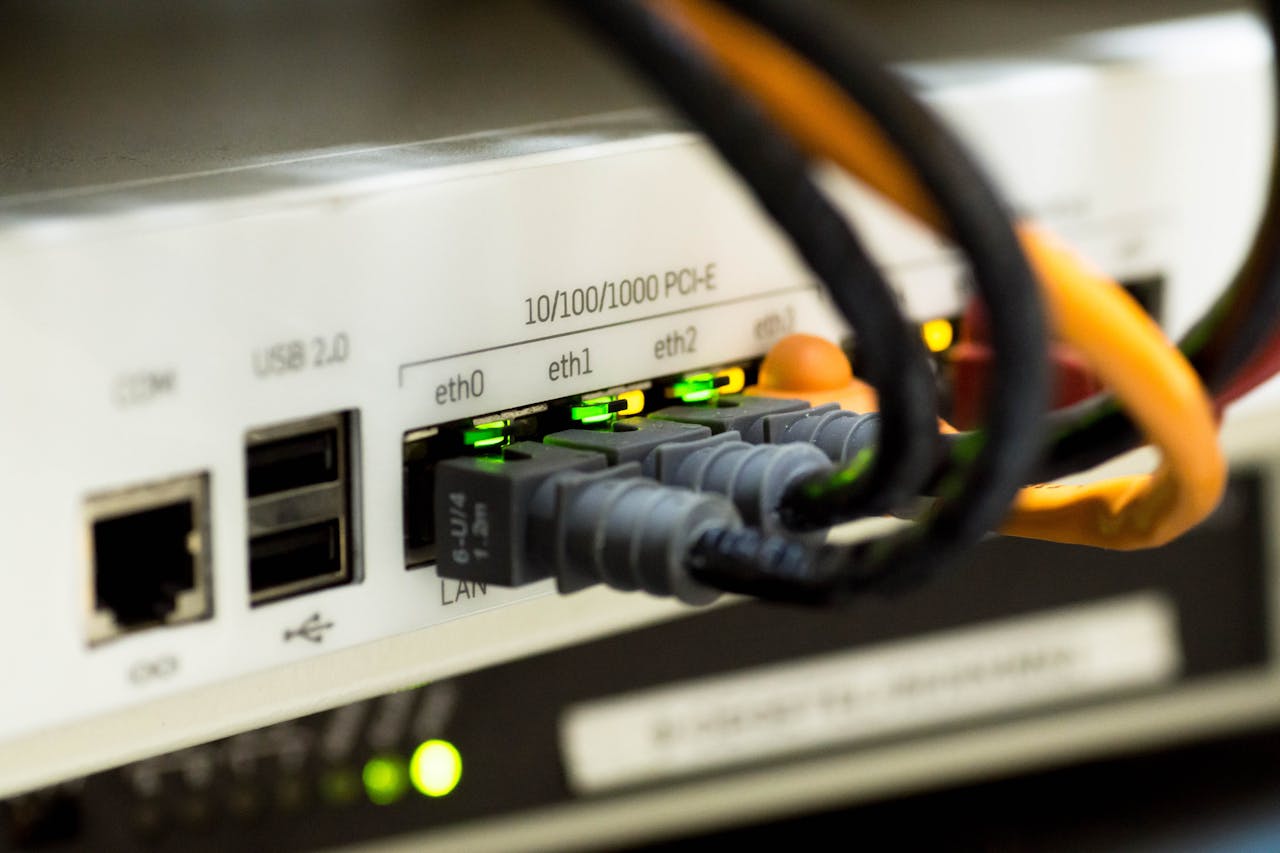Navigating the choice between DSL vs cable internet is helpful for optimizing your online experience – from streaming and gaming to web browsing and downloading.
This comparison delves into the technological foundations, speed potentials, and availability of DSL and cable internet, highlighting their respective benefits and limitations. It covers essential considerations such as connection reliability, pricing strategies, and the impact of emerging technologies on future internet service landscapes.
By understanding these key differences, consumers can make informed decisions tailored to their specific internet usage needs and geographical constraints.
Choose VMedia for High-Speed, Unlimited Internet. Explore the possibilities now.
Understanding DSL and Cable Internet
When choosing between DSL (Digital Subscriber Line) and Cable Internet services, one should consider the differences in technology, types of connections, and their development to make an informed decision.
Technology Basics
DSL Internet utilizes existing telephone lines to transmit data, providing high-speed internet over copper wires. It’s often considered a step above dial-up due to its ability to use the line while also making phone calls. Transmission speeds can range from 3 Mbps to 115 Mbps.
Cable Internet, on the other hand, employs coaxial cable technology, which is the same cabling used for cable television. This allows for significantly higher bandwidth potential than DSL, offering speeds from 10 Mbps to 1,200 Mbps.
Connection Types
- DSL typically offers a dedicated connection from the internet service provider to an individual’s home. This means that the broadband connection is not typically shared with neighbours, leading to more consistent speed without fluctuations during peak hours.
- Cable Internet involves a shared network, which might lead to congestion and slower speeds during peak usage times as multiple homes are often connected to the same local line.
Historical Development
The advent of DSL was seen as an evolution in the use of telephone lines, allowing for continuous internet connectivity and more efficient use of the phone line infrastructure without disrupting voice services.
Cable Internet emerged with the expansion of broadband services, leveraging the existing coaxial cable infrastructure initially used for television services to also handle high-speed internet data, rapidly increasing internet access speeds and changing expectations for what constitutes “fast” internet.
Speed and Performance
When choosing between DSL and cable internet, consumers typically consider how speed and performance will affect their online activities. This section breaks down the key aspects of speed comparison, bandwidth and data transfer, and latency and connection stability.
Speed Comparison
DSL internet typically provides speeds up to 100 Mbps, which may be sufficient for basic browsing and streaming. In contrast, cable internet offers significantly faster download speeds, often reaching 1,000 Mbps or more, making it a superior choice for heavy streaming, gaming, and downloading large files.
- DSL: Up to 100 Mbps
- Cable: Up to 1,000 Mbps
Bandwidth and Data Transfer
Bandwidth is a measure of the maximum rate at which data can be downloaded or uploaded over an internet connection. Cable internet generally offers higher bandwidth than DSL, translating to better performance during high-demand scenarios.
With more bandwidth, multiple users can stream, game, and download simultaneously without significant impact on overall speed.
- DSL: Lower bandwidth, may struggle with multiple users
- Cable: Higher bandwidth, supports multiple high-speed connections
Latency and Connection Stability
Latency refers to the delay before data transfer begins following an instruction for its transfer, with both DSL and cable averages under 25 milliseconds (ms). While connection stability for DSL can suffer over greater distances from the provider, cable internet often provides more reliable connections due to its infrastructure.
- Latency: Both DSL and cable often have similar latency
- Reliability: Cable usually offers more stable connections, especially over long distances
Availability and Coverage
When considering DSL and cable internet options, coverage can vary greatly depending on geographic location, existing infrastructure, and the presence of internet providers.
Geographic Reach
DSL internet utilizes existing telephone lines to provide service, which makes it widely available, especially in urban and suburban areas where these lines are already in place.
It historically has a broad reach, making it a common choice for many households. In contrast, cable internet is offered through coaxial cable lines, which are also widespread but typically follow the distribution of cable television services.
Rural Accessibility
In rural areas, DSL internet is often the more accessible option. The infrastructure for DSL, based on copper phone lines, is more likely to exist in these remote locations.
Cable internet, however, can be limited due to the higher costs associated with extending the necessary infrastructure for service.
| Internet Type | Accessibility in Rural Areas |
| DSL | Widely available |
| Cable | More limited |
Infrastructure Constraints
The infrastructure for both DSL and cable internet has its limitations. DSL speeds can be significantly constrained by the distance from the provider’s local office or hub. The further the distance, the weaker the signal and the slower the speeds.
Cable internet, while generally offering higher speeds, can suffer from network congestion as bandwidth is shared among users in the same area, potentially slowing down during peak usage times.
Ultimately, the availability and quality of service from internet providers for either DSL or cable can be influenced by the local and regional infrastructure.
Potential subscribers should verify with local ISPs about the type of internet services available in their specific area and any possible constraints on speed or reliability.
Experience the Best in Internet Connectivity with VMedia. Discover your options today.
Installation and Equipment
Consumers should consider the installation process and necessary equipment when deciding their internet connectivity. These factors influence the initial setup, long-term usage, and maintenance needs.
Set-up Process
The installation process for both DSL and cable internet typically requires a professional technician to visit the consumer’s home. They ensure proper connection to the network and configure the settings for optimal performance.
DSL installation connects through existing phone lines, while cable installation involves coaxial cable connections. The installation time can vary, but most providers strive for quick and efficient service to minimize disruption.
- DSL: Connects to phone line; may require less complex installation.
- Cable: Utilizes coaxial cable; possible shared connection with cable TV service.
Required Hardware
Customers will need key hardware components: a modem and possibly a router. For DSL internet, a DSL modem is required, which may differ from the cable modem used for cable internet. Most providers offer these modems for purchase or for a monthly rental fee.
- Modem: Essential for connecting to the ISP’s network.
- DSL Modem: Specific to DSL service.
- Cable Modem: Specific to cable service.
Some consumers may opt for a combination device that includes both modem and router functions. An Ethernet cable might be necessary to connect the modem to a computer or router directly.

Maintenance and Upgrades
Over time, technology evolves, prompting the need for maintenance or upgrades to the equipment.
While DSL modems and routers tend to have a longer lifespan, the advancements in velocity and reliability may require an earlier upgrade for consumers seeking faster internet speeds.
Cable modems and infrastructure see more frequent upgrades due to the nature of cable technology and the pursuit of higher bandwidth capacities.
- Maintenance: Regularly assess equipment for updates or issues.
- Upgrades: Replacement or upgrade of modems and routers for improved performance or to keep up with speed advancements from the ISP.
Installation costs can vary, and it’s important for customers to verify whether it’s a one-time fee or included in the service. The cost of equipment, whether rented or purchased outright, will contribute to the overall investment in the service.
Service Quality and Customer Experience
When selecting between DSL and cable internet, customers generally consider reliability, the quality of customer support, and the reputation of the provider. These factors significantly impact the overall satisfaction with an internet service.
Reliability and Uptime
DSL (Digital Subscriber Line) internet operates over telephone lines and tends to have a more consistent speed, which is not influenced by peak usage times. However, because DSL speed is often limited to a maximum of 100 Mbps, it may struggle to keep up with the demands of heavy internet use.
Cable internet, by contrast, typically offers higher top speeds, extending up to 1200 Mbps and growing. It is particularly robust during periods of heavy use, although customers may experience some speed reduction during peak hours if they use a provider utilizing shared bandwidth in neighborhoods.
Customer Support and Satisfaction
Customer support varies widely among providers. Cable and DSL service providers are constantly evaluated by customers, with reviews highlighting responsiveness, helpfulness, and accessibility of support.
Many providers have 24/7 helplines and online chat support, intending to provide an “always-on” presence for troubleshooting.
| Provider Type | Support Features |
| DSL | 24/7 helplines, Online support |
| Cable | 24/7 helplines, Online support, Technician visits |
Company Policies and Reputation
Company policies, such as terms of service, data caps, and pricing, can affect customer satisfaction. Providers may differ in their policies, with some being seen as more customer-friendly than others.
The reputation of an internet service provider often ties back to how transparent and fair they are perceived in their dealings with customers.
Both DSL and cable internet providers encounter outages, but cable’s advanced infrastructure typically allows for faster resolution times. The reputation of a provider may also influence new customer decisions, as established providers with a history of reliability and fairness tend to be preferred.
Additional Features and Uses
When selecting an internet service, consumers should consider additional features and uses such as support for high-bandwidth activities, integrated security measures, and compatibility with smart home devices.
Streaming and Gaming
Streaming services like RiverTV require a stable, high-speed internet connection for a smooth viewing experience. Cable internet’s higher bandwidth is ideal for streaming high-definition content. For online gaming, a consistent and fast connection is crucial.
Cable’s faster download speeds and better data throughput support seamless gaming and high-quality video streams, mitigating lag and buffering issues.
Online Security
The integrity of a user’s email and other sensitive communications depends significantly on the security features offered by their internet provider.
Cable internet providers offer additional security services to protect users’ data and identity while browsing or performing online transactions.
These might include antivirus software, firewalls, and secure Wi-Fi setups that help prevent unauthorized access and cyber threats.
Internet of Things Compatibility
Smart devices such as thermostats, lights, and security cameras, all part of the Internet of Things (IoT), require a reliable internet connection to function properly.
Cable internet provides the robust and continuous connection that these devices need to operate effectively.
This is even more relevant for homes with multiple IoT devices where a steady connection is vital for video conferencing and real-time device management.
Unlock the Power of VMedia’s Reliable Internet Service. Find your perfect match here.
Pros and Cons of DSL vs Cable
Let’s explore the distinct advantages and limitations DSL and Calbe offer, particularly regarding speed, value, and reliability.
Advantages of DSL
- Availability: DSL is accessible in many areas because it operates through existing telephone lines.
- Consistency: It tends to have a dedicated line for each customer, reducing fluctuations in speed during peak hours.
Advantages of Cable
- Higher Speeds: Cable generally offers higher top speeds than DSL, leveraging the capability of coaxial cable lines.
- Bandwidth: Ideal for high-bandwidth activities due to its faster data transfers.
Limitations and Considerations
DSL:
- Speed: DSL speeds usually cap out at 100 Mbps, although a few providers offer plans with speeds up to 500 Mbps.
- Technology: The reliance on older copper wire technology can limit the potential for future speed upgrades.
Cable:
- Value: While typically faster, cable can also be more expensive than DSL, reflecting its higher performance.
- Reliability: Usually dependable, yet service can be affected by the number of users sharing the local connection at any given time.
Future Trends and Innovations
In the competitive landscape of digital connectivity, emerging technologies, regulatory impacts, and market evolution are pivotal areas influencing the future of DSL and cable internet provisions.
Emerging Technologies
Fibre Internet is at the forefront of emerging technologies in internet connectivity, offering unprecedented internet speeds due to its capability to transmit data as light signals.
Providers are increasingly investing in fibre to accommodate rising bandwidth demands. Satellite Internet is another burgeoning technology, with companies like Starlink enhancing global connectivity, particularly in underserved areas, through advanced satellite constellations.
Market Evolution
Market evolution in broadband is characterized by the transition from legacy systems such as dial-up to more sophisticated offerings.
The push for higher frequency bands and the continuous quest for improving internet speeds have led to the integration of hybrid solutions combining fibre and coaxial technologies in the cable sector. Providers are adapting to remain competitive in an environment where consumers demand rapid and reliable internet access.

Decision Making and Recommendations
In the quest to equip one’s home or office with the best possible internet service, reliability, cost, availability, and speed ranges are critical factors in making an informed decision.
Choosing the Right Service for Your Needs
When selecting an internet service, individuals need to assess their internet usage patterns. Light users who primarily browse the web and check emails may find DSL (Digital Subscriber Line) to be a cost-effective and sufficient option.
In contrast, cable internet, with higher download speeds, suits households or businesses with multiple heavy internet users who stream in high definition, game online, and download large files.
Reliability is another aspect to consider. While cable internet is susceptible to decreased performance during peak usage times, DSL offers a more consistent speed as it’s a dedicated line. However, the actual availability of these services depends on one’s location.
Rural areas might have limited cable internet options but more DSL coverage. It is advantageous to verify which services are accessible at one’s address before making a decision.
Comparative Analysis
| Feature | DSL | Cable Internet |
| Download Speed Range | Up to 100 Mbps | 10 Mbps to 1,200 Mbps |
| Upload Speed Range | Lower than download speeds | Typically higher than DSL |
| Cost | About $20-$70/month | About $20-$125/month |
| Speed Reliability | More consistent | May vary during peak hours |
As displayed, the download speed range for DSL typically caps at 100 Mbps, whereas cable internet can offer speeds over 1 gigabit per second or 1,200 Mbps.
Insights
Cable internet is often the preferred choice for those requiring higher bandwidth for demanding activities, such as gaming or streaming in 4K.
Also consider the long-term costs, as promotional prices can change and impact one’s budget over time. When it comes to megabits per second (Mbps), consumers should match their speed needs with the plan they choose, ensuring that they’re not paying for more than they use or settling for less than they need.
DSL vs Cable – Final Thoughts
In the evolving digital landscape, selecting an internet service that aligns with your needs for speed, reliability, and cost is paramount.
VMedia offers a range of internet plans designed to cater to diverse preferences, whether you lean towards the consistency of DSL or the higher speeds provided by cable connections. With VMedia, customers benefit from flexible, high-quality internet services without the burden of long-term contracts, allowing for an adaptable online experience.
Explore VMedia’s internet options today to find a plan that best suits your digital lifestyle, ensuring seamless connectivity and optimal online performance. Click here to get started!

